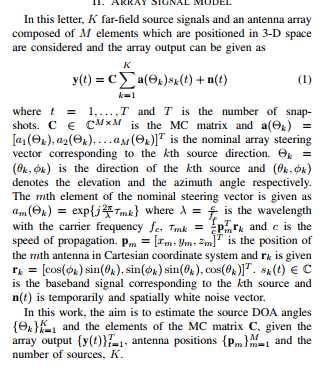标签:sea mamicode -- 空间 rand 源代码 元素 大小 运用
-------场景的搭建
M = 15;% the num of antenna L = 100; % the num of snapshot theta = [10 30]; %the DOA K = length(theta); %the num of the signal SNR = 10; searchgrid = 0:0.01:90;
------信号模型的搭建
S = (randn(K,L)+j*randn(K,L))/sqrt(2);
loc = zeros(M,3);
loc(:,1) = 0:M-1;
A = zero(M,K);
for k = 1:K
rk = [cosd(phi(k))*sind( theta(k)),sind(phi(k))*sind(theta(k)),cosd(theta(k))].‘;
% rk = [cos(φk) sin(θk); sin(φk) sin(θk); cos(θk)]T
A(:,k) = exp(-j*pi*loc*rk);
end
X0 = A*S;
Y = awgn(X0,SNR,‘measured‘,‘dB‘);

这里采取二维空间的信号模型,对于A中的元素赋值参考上诉文献。
------信号二阶统计特征的得到
R = Y*Y‘/L; [V,D] = eig(R); %V:the characterist vector;D: the characterist value :all is matrix DD = diag(D); En = V(:,1:M-K);% the noise subspace
------DOA估计(以MUSIC为例)
Un = En*En‘;%En‘转置操作
temp = zeros(3,length(searchgrid1));%源代码中运用了三种估计方法
phi1 = 0;%一维空间
tic,
for num1 = 1:length(searchgrid1)
theta1 = searchgrid1(num1);
r1 = [cosd(phi1)*sind(theta1),sind(phi1)*sind(theta1),cosd(theta1)].‘;
aa = exp(-j*pi*loc*r1);% direction matrix
temp(1,num1)=1/abs(aa‘*Un*aa);%the objective function
end
tem_2(1) = tem_2(1)+toc;% the time spend
------谱峰搜索
maxt1 = max(temp(1,:)); temp2 = 10*log(temp(1,:)/maxt1);%归一化并去对数使谱峰明显 [val2,indx2] =findpeaks(temp2);%val2为峰值大小,indx2为位置 [sval2,pos2] = sort(val2,‘descend‘);%sval2为降序排号的序列,pos2为索引地址 E_theta1 = sort(searchgrid1(indx2(pos2(1:K))));
标签:sea mamicode -- 空间 rand 源代码 元素 大小 运用
原文地址:https://www.cnblogs.com/czl-01/p/13055269.html